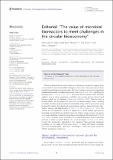| dc.contributor.author | Wan-Mohtar, Wan Abd Al Qadr Imad | |
| dc.contributor.author | Ilham, Zul | |
| dc.contributor.author | Rowan, Neil J. | |
| dc.date.accessioned | 2023-04-06T09:46:44Z | |
| dc.date.available | 2023-04-06T09:46:44Z | |
| dc.date.copyright | 2023 | |
| dc.date.issued | 2023-04-05 | |
| dc.identifier.citation | Wan-Mohtar, W.A.A.Q., Ilham, Z., Rowan, N.J. (2023). Editorial: "The value of microbial bioreactors to meet challenges in the circular bioeconomy".. Frontiers in Bioengineering and Biotechnology. 11:1181822. doi: 10.3389/fbioe.2023.1181822. | en_US |
| dc.identifier.issn | 2296-4185 | |
| dc.identifier.uri | https://research.thea.ie/handle/20.500.12065/4465 | |
| dc.description.abstract | The use of microbial bioreactors has harnessed immense attention to support many
of the United Nation’s Sustainable Development Goals where this innovative platform
provides crucial insights into unlocking a diversity of solutions to society ranging from
fundamental research to hydrocarbon purification (Ghosh et al., 2023) and living lab
demonstrations (O’Neill et al., 2022). Bioreactor-based solutions have desirable
qualities such as safety compliance, scalability, non-toxicity, proven culture-based
processes, and ease of operation (Rowan and Galanakis, 2020). There has been a
growing interest in the progress of bioreactors to improve supply chains, enabling
circularity (the bioeconomy) and food sustainability, along with the potential of using
bio-based properties from food and waste products, which is aligned with the “One-
Health” concept and digitalization (O’Neill et al., 2022; Rowan et al., 2022). The
creative use of bioreactors can also be exploited as a novel toolbox approach for
informing and modeling the potential impact of climate change variance on aquatic
ecosystems, including testing new green innovation aligned with biodiversity (O’Neill
et al., 2022). In recent years, researchers have adopted bioreactor-based cultivation
methods to utilize microbial biomass for social advantages (O’Neill et al., 2022).
Overall, the manuscripts presented in this Research Topic provided significant
paradigms for the usage of bioreactors (Figure 1), which will benefit academia,
bioreactor manufacturers, cultivation technologists, small–mid-sized enterprises
(SMEs), and factory technicians. | en_US |
| dc.format | PDF | en_US |
| dc.publisher | Frontiers | en_US |
| dc.relation.ispartof | Frontiers in Bioengineering and Biotechnolgy | en_US |
| dc.rights | Attribution-3.0 United States | * |
| dc.rights.uri | http://creativecommons.org/licenses/by/3.0/us/ | * |
| dc.subject | Bioreactor | en_US |
| dc.subject | Biomass | en_US |
| dc.subject | Fermentation | en_US |
| dc.subject | Sustainability | en_US |
| dc.subject | Bioeconomy | en_US |
| dc.subject | UN Sustainable Development Goals | en_US |
| dc.title | Editorial: "The value of microbial bioreactors to meet challenges in the circular bioeconomy". | en_US |
| dc.type | info:eu-repo/semantics/contributionToPeriodical | en_US |
| dc.contributor.affiliation | Technological University of the Shannon: Midlands Midwest | en_US |
| dc.contributor.sponsor | Ministry of Higher Education (MOHE) under the Fundamental Research Grant Scheme (FRGS: FP062-2022) (FRGS/1/2022/STG01/UM/02/2). MSCA RISE ICHTHYS Project (No. 872217) | en_US |
| dc.description.peerreview | yes | en_US |
| dc.identifier.doi | 10.3389/fbioe.2023.1181822. | en_US |
| dc.identifier.orcid | https://orcid.org/0000-0002-5384-4325 | en_US |
| dc.identifier.orcid | https://orcid.org/0000-0003-1228-3733 | en_US |
| dc.identifier.volume | 11 | en_US |
| dc.subject.department | Empower Eco Research Institute. Technological University of the Shannon: Midlands Midwest | en_US |
| dc.type.version | info:eu-repo/semantics/publishedVersion | en_US |


